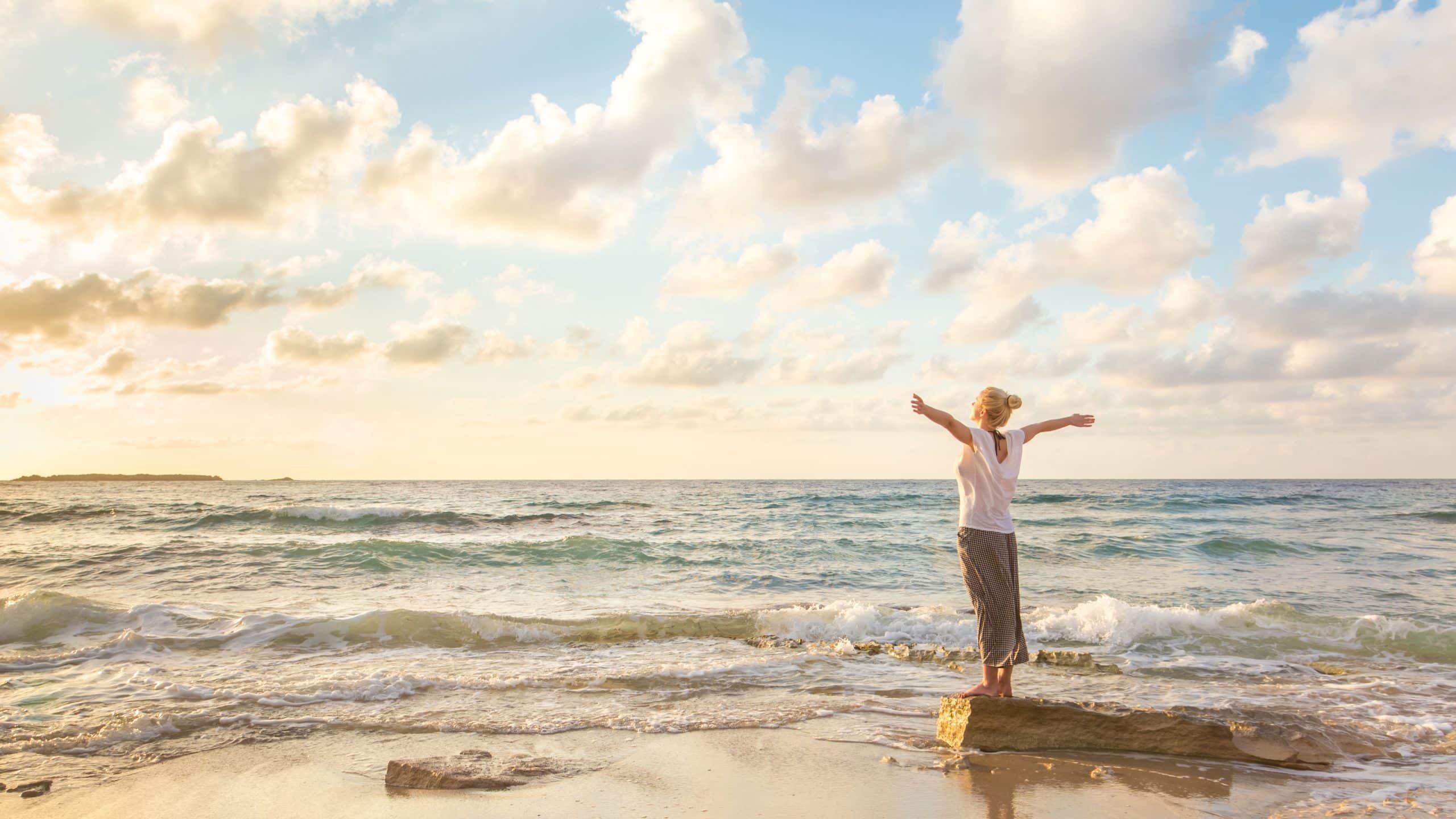You might have seen an Insta influencer start their day with an ice-cold shower, then flaunt their supple skin as proof of the benefits of their morning ritual. Or, perhaps, an athlete who swears by an icy soak after a grueling workout to speed up recovery.
Of course you’re wondering – is cold water some magical elixir that you should be incorporating into your routine?
Well, the research on cold water therapy is still in its early stages. However, there’s some compelling evidence suggesting it may offer numerous health benefits.
We’ve compiled six noteworthy benefits of cold water therapy that might just have you turning down the heat next time you step into the shower.
What Is Cold Water Therapy?
Also known as hydrotherapy, cryotherapy, or ice therapy, cold water therapy is a wellness technique that involves the use of cold water to enhance health and healing (1).
It may take on the following forms, each introducing cold in some form to the body:
- Cold Showers: This is the simplest form of cold water therapy which involves taking a regular shower but with cold water.
- Cold Water Immersion: This involves submerging the entire body, or a part of the body, in cold water for a period of time.
- Ice Packs: These are small packs filled with ice or cold water that can be placed on a specific area of the body to reduce inflammation and pain.
- Ice Baths: Similar to cold water immersion, but specifically involves submerging in ice-filled water.
- Cryotherapy Chambers: This involves standing or lying in a chamber where cold, dry air is circulated.
- Cold Water Swimming: Swimming in cold open waters, like lakes or the ocean, can be a form of cold water therapy.
- Contrast Water Therapy: This is also called hot cold shower therapy; where you switch from different temperatures for most benefit.
- Cold Water Face Dunks: This practice involves repeatedly immersing your face in a basin filled with cold water.
Cold water therapy is rooted in both historical practices and contemporary wellness trends. Ancient societies used snow to help with inflammation, and with the current wave of athletes plunging into ice baths post-workout, the concept isn’t new.
The effectiveness of cold water therapy is based on thermoregulation. Thermoregulation is the body’s ability to maintain internal heat levels and, when exposed to cold temperatures, the body has to work harder to produce heat (9).
It is thought that this energy-intensive process triggers reactions in our bodies that may have various health benefits.
BetterMe app will kick you out of the mental funk, shake off your extra weight, rid you off your energy-zapping habits, and help you sculpt the body of your dreams. Intrigued? Hurry up and change your life for the better!
What Is Cold Water Therapy Good For?
Cold water therapy can be a useful tool for promoting various aspects of physical and mental well-being. From athletes seeking relief from muscle soreness to people aiming to boost their metabolism or improve circulation, cold water therapy is a versatile strategy with an extensive range of potential benefits.
Now let’s take a deep dive into some of these science-backed benefits:
Relieving Muscle Soreness
If you’ve ever watched athletes plunge into an ice bath post-training, or take a cold shower after a workout; they’re relying on cold water therapy to soothe their tired and sore muscles.
Scientists suggest that the cold helps constrict blood vessels and decrease metabolic activity, which reduces swelling and tissue breakdown (10).
Furthermore, once the skin is no longer in contact with the cold source, the underlying tissues warm up, causing a faster return of blood flow, which helps move the by-products of cellular breakdown to the lymph system for efficient recycling by the body.
Cold water therapy may be an effective way to reduce muscle soreness and help athletes recover faster after intense workouts (4).
Stimulating The Immune System
Cold water therapy is also believed to stimulate the immune system by increasing the flow of lymph, a fluid in your body that helps remove waste and toxins from your bodily tissues.
Research shows that repeated cold water immersion causes an increase in metabolic rate due to shivering that increases the concentration of catecholamines that slightly activates the immune system (6).
Furthermore, a 1996 study found that individuals who regularly immersed themselves in cold water had an increase in white blood cells and several other immune system metrics, compared to individuals who did not (6).
While more research is needed, preliminary studies suggest that cold water therapy might be a practical way to boost your immune system’s performance.
Decreasing Depressive Symptoms
This might sound surprising, but cold water therapy benefits for mental health are numerous. Depression is a complex disorder with a variety of treatment options, one of which may be cold water therapy.
Some research indicates that cold showers result in an increase in noradrenaline levels, which is a chemical that could help mitigate depression symptoms (5).
Cold water therapy is also believed to increase endorphin levels. These “feel good” hormones can give us a sense of happiness and positivity (5).
A 2008 study found that cold water therapy can relieve depressive symptoms significantly by sending an overwhelming amount of electrical impulses from peripheral nerve endings to the brain (12).
As a result, it produces an antidepressant effect, and boosts moods, making it a potentially helpful part of a depression treatment plan.
Boosting Metabolism
Cold water therapy can kick your metabolism into high gear. When our bodies are exposed to cold they need to work harder to stay warm. This process, known as thermogenesis, can result in increased metabolic rate and subsequently the burning of more calories.
According to a study published in the Journal of Clinical Endocrinology and Metabolism, participants exposed to cold had an increase in the number of metabolically active brown adipose fat (6).
This means, regular cold showers or any other form of cold water therapy weight loss benefits could potentially be a supportive measure in weight management plans.
Improving Circulation
Cold water therapy can also improve circulation by forcing your body to circulate blood more efficiently.
When you immerse your body in cold water, your blood vessels constrict, and when you get out, they dilate (or open back up). This process helps to improve your cardiovascular health by enhancing blood flow and supplying oxygen and nutrients more efficiently throughout your body.
Improved circulation may also improve your skin and hair health. When the body becomes more efficient at circulating blood, it provides more oxygen and nutrients that help skin cells regenerate faster. This could explain why some people have reported having smoother and shinier hair after a cold bath or shower.
Preventing Overheating
It might sound counterintuitive, but cold water therapy can help prevent overheating during intense workouts or in hot conditions.
When your body temperature starts to rise, the cold water can help bring it back down. By preventing overheating, cold water therapy can help prevent heat-related illnesses such as heat stroke during intense physical activity.
Moreover, a 2012 study published in the Journal of Athletic Training found that cold water immersion was more effective than rest or active recovery at reducing body heat strain in athletes (2).
So in the summer heat, immersion in cold water could be a great way to cool your body down and prevent overheating.
Read more: 15 Facial Exercises for a Radiant, Youthful, Defined, and Slimmer Face.
What Are The Downsides of Cold Water Therapy?
Although the benefits of cold water therapy are impressive, there are some potential downsides of this practice.
First, sudden immersion in cold water can cause shock to your body, leading to an increase in heart rate and blood pressure. This could be risky for individuals with cardiovascular issues (3).
Second, cold water can be quite a shock to the system, which may cause hyperventilation in the initial stages, particularly for those unaccustomed to cold water therapy (3). Hyperventilation can lead to feelings of anxiety or stress, detracting from the relaxation benefits of the therapy.
Third, some people may find cold water therapy uncomfortable or intolerably cold, which could discourage them from maintaining this practice in the long term.
Lastly, while cold water therapy can boost your metabolic rate and potentially aid in weight loss, it should not be considered a standalone solution for weight loss.
Not only is research limited on this subject, but any positive effects are likely to be minimal and could be easily outweighed by diet and exercise. You can read more about this in our piece titled Do Cold Showers Burn Fat.
How Long Should You Stay In Cold Water Therapy?
Are you curious about how to start ‘cold water therapy?’A few minutes of cold water therapy may be a good starting point. The exact duration of cold water therapy can vary greatly depending on your tolerance, health conditions, and the specific goals you seek to achieve.
Here’s a general guideline you might find helpful in deciding cold water therapy how long to do it for:
- Gauge tolerance with short exposures: If you are new to cold water therapy, it could be beneficial to start with short exposures, such as a 30-second cold shower, and gradually increase the duration over time.
- Consider 2-3 minute sessions for beginners: Some experts recommend starting with 2-3 minute sessions of cold water immersion, gradually building up your tolerance and duration as your body becomes accustomed to the cold.
- 10-15 minutes for more experienced users: Individuals who are more used to the cold may benefit from longer sessions, such as 10-15 minutes in cold water. This duration can have a more significant impact on circulation, depression symptoms, and metabolism.
- Don’t overdo it: If you begin to feel excessively uncomfortable, it’s a sign you should end your session. If you overdo it, you put yourself at risk for hypothermia which is one of the most common cold water therapy dangers. It’s important to take the necessary safety precautions.
Looking for a way to break the vicious cycle of weight loss and tone up all the jiggly parts? Watch the extra pounds fly off and your muscles firm up with the BetterMe app!
Frequently Asked Questions
What Happens After 30 Days of Cold Showers?
After 30 days of consistent cold showers you might notice several changes in your body. These may include increased alertness, improved mood, strengthened immune response, enhanced circulation, and better skin and hair condition due to the decreased loss of natural oils.
You may also experience metabolic changes, such as a potential increase in weight loss efficiency, although this isn’t a standalone solution for weight loss.
What Does a 5-minute Cold Shower Do?
A 5-minute cold shower can stimulate the nervous system, increase blood circulation, and cause a rush of endorphins – the feel-good hormones. It can also improve your mood by acting as a mild antidepressant and boost your energy levels, making you feel more alert.
On the physical level it can help improve the quality of your skin and hair, by preserving their natural oils which often get stripped off with hot water.
Does Cold Water Therapy Burn Fat?
Yes, cold water therapy can contribute to fat burning. The theory is that exposure to cold can stimulate the development of brown fat, which is a type of fat that burns energy instead of storing it (7). This process is known as thermogenesis.
However, it is important to note that while cold water therapy can support weight loss efforts, it is not a standalone solution for weight loss and should be combined with a balanced diet and regular exercise (11).
How Often Can You Do Cold Water Therapy?
The frequency of cold water therapy can vary depending on your personal tolerance, health conditions, and desired outcomes.
Some people engage in cold water therapy at home daily, while others do it several times a week. It’s always best to listen to your body and adjust the frequency accordingly.
Who Should Not Use Cold Therapy?
Individuals with certain health conditions, such as cardiovascular disease, Raynaud’s disease or asthma, should avoid cold water therapy as it could potentially worsen their symptoms or cause a sudden heart attack in those with weak hearts (3).
Pregnant women are also advised to avoid this therapy as it may put undue stress on the body. Always consult your healthcare provider before starting a new therapy regimen.
Is There Any Science Behind Cold Water Therapy?
Yes, there is scientific evidence supporting the benefits of cold water therapy.
Studies have shown that it can boost mood, improve circulation, increase metabolism, improve skin and hair health, and even help with depression (1). However, more research is needed to fully understand all its potential benefits and risks.
What Hormone is Released During an Ice Bath?
The primary hormone released during an ice bath is norepinephrine, also known as noradrenaline. This hormone is part of the body’s fight-or-flight response and is released in response to stress, such as the stress caused by sudden cold exposure (8). Norepinephrine can boost mood, stimulate the immune system, and help the body burn fat more efficiently.
The Bottom Line
In conclusion, cold water therapy can bring a host of health benefits which may be worth considering if you’re looking to improve your physical and mental wellbeing. Its effects on mood, circulation, metabolism, skin and hair health have been well-documented in the scientific literature. The best approach is to gauge your tolerance and start with short exposures of cold water. Be sure to talk to your healthcare provider before engaging in this practice, as it is unsafe for certain individuals.
DISCLAIMER:
This article is intended for general informational purposes only and does not address individual circumstances. It is not a substitute for professional advice or help and should not be relied on to make decisions of any kind. Any action you take upon the information presented in this article is strictly at your own risk and responsibility!
SOURCES:
- Cold for centuries: a brief history of cryotherapies to improve health, injury and post-exercise recovery (2022, link.springer.com)
- Cold water immersion recovery following intermittent-sprint exercise in the heat (2012, pubmed.ncbi.nlm.nih.gov)
- Cold Water Swimming—Benefits and Risks: A Narrative Review (2020, ncbi.nlm.nih.gov)
- Cold‐water immersion (cryotherapy) for preventing and treating muscle soreness after exercise (2012, ncbi.nlm.nih.gov)
- Health effects of voluntary exposure to cold water – a continuing subject of debate (2022, tandfonline.com)
- Immune system of cold-exposed and cold-adapted humans (1996, pubmed.ncbi.nlm.nih.gov)
- Increased Brown Adipose Tissue Oxidative Capacity in Cold-Acclimated Humans (2004, academic.oup.com)
- Physiology, Stress Reaction (2022, ncbi.nlm.nih.gov)
- Physiology, Temperature Regulation (2023, ncbi.nlm.nih.gov)
- The effects of cold water immersion and active recovery on inflammation and cell stress responses in human skeletal muscle after resistance exercise (2016, ncbi.nlm.nih.gov)
- Weight-Loss and Maintenance Strategies (2004, ncbi.nlm.nih.gov)
- Whole-body cryotherapy as adjunct treatment of depressive and anxiety disorders (2008, link.springer.com)














